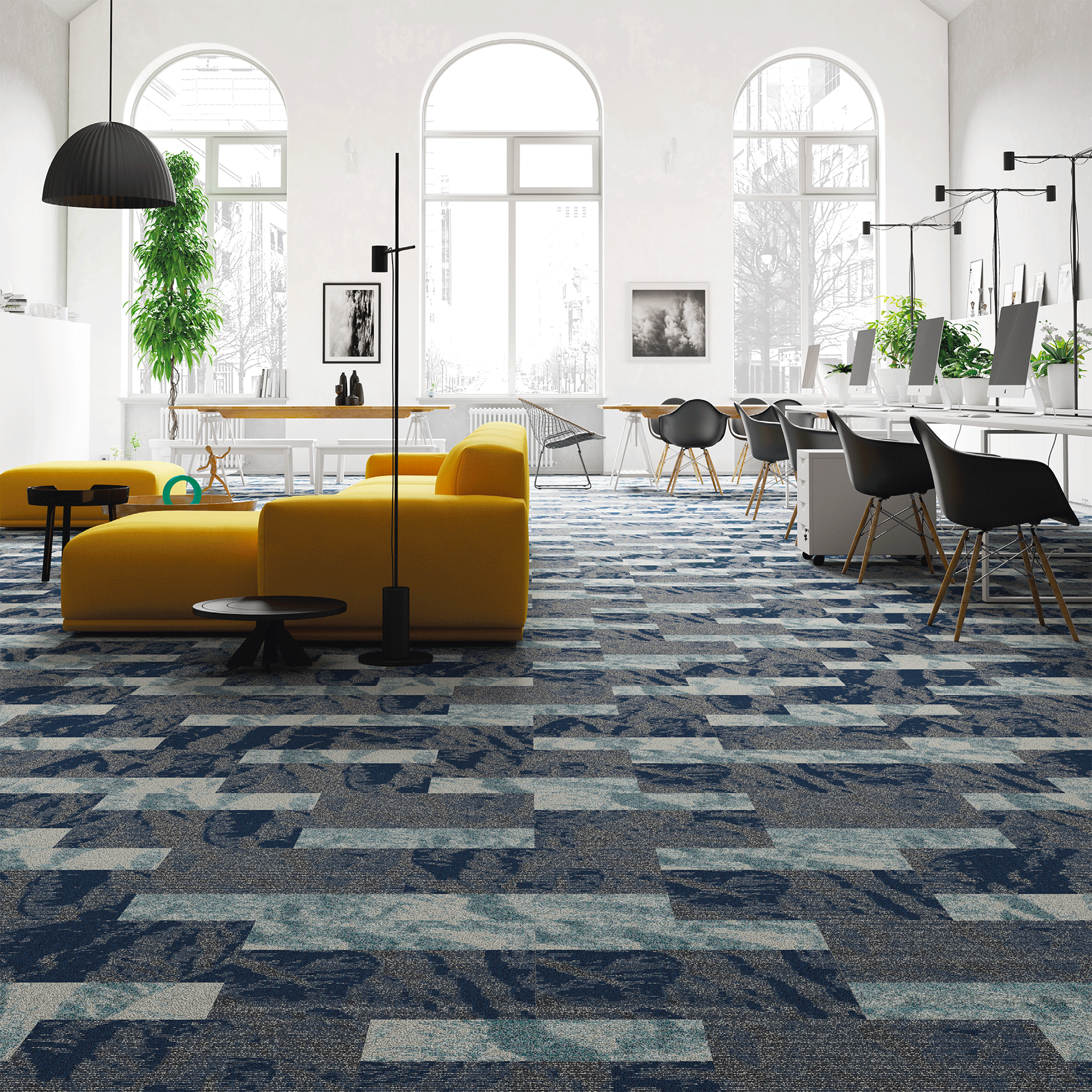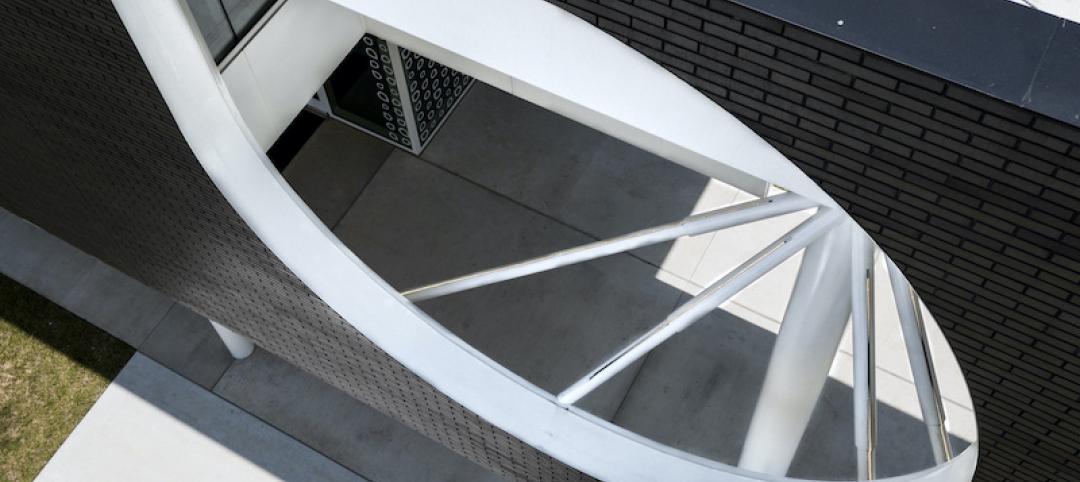The design industry has long been pervaded by the idea that sustainable materials are “not enough”—not flexible or durable enough, not creative enough, not inexpensive enough to justify their use.
These outdated notions have prevented industry professionals from taking advantage of new advances and products. Innovations like ECONYL® regenerated nylon have proven that materials made from waste can perform on par with virgin materials, all without sacrificing form or function.
 Masland Contract Taps into ECONYL® regenerated nylon to create their contemporary carpet tile line, “Crafted”
Masland Contract Taps into ECONYL® regenerated nylon to create their contemporary carpet tile line, “Crafted”
Count on Performance
When it comes to choosing between material made from waste and virgin raw material, performance level is often debated. But it’s a problem that doesn’t exist anymore. The development of new technologies and manufacturing processes has given way to sustainable materials that can have the same performance level as virgin material.
Floors covered by carpet made from ECONYL® regenerated nylon fibers have the same performance as virgin nylon carpet.
What makes these floors durable and long-lasting? It goes back to the ECONYL® Regeneration System, which transforms nylon waste into brand new nylon yarn. This process, called depolymerization, breaks nylon waste down into its chemical building blocks and then forms new nylon polymers which are spun into nylon yarn.
 The latest commercial collection by Venture Contract is made with ECONYL®
The latest commercial collection by Venture Contract is made with ECONYL®
Unleash Creativity
Performance is just one part of the puzzle. Aesthetics are also a key consideration when it comes to choosing materials, and despite outdated misconceptions, sustainable materials don’t limit creativity or prevent beautiful results.
ECONYL® yarn is available in 170 colors, all of which allow customers to maintain color consistency in their performance-driven carpets, rugs, and carpet tiles. This diverse set of options allows for beautiful results and a range of different styles.
Reduce Waste and Fight Climate Change
Did you know that 4 billion pounds of carpet is discarded in landfills each year in the U.S.? Only 5 percent of this carpet waste is recycled.
The numbers are no surprise—flooring and carpets are some of the most frequently replaced parts of commercial buildings.
Through its two recycling facilities in Woodland, California, and Phoenix, Arizona, Aquafil is dedicated to reducing the environmental impact of carpet waste. Each facility has the capacity to collect and recycle 36 million pounds of carpet each year, which translates to 25,000 square yards of carpet diverted from landfills each day.
Beyond its recycling efforts, Aquafil has found resourceful ways to recover nylon waste by engaging in various global environmental and social programs, such as the Healthy Seas Initiative.
Through this, Aquafil spreads awareness of ocean conservation issues and protects marine life through the recovery of abandoned fishing nets, which are responsible for millions of deaths of marine animals each year.
This recovered nylon waste is transformed into new yarn, which has the same characteristics as nylon made of virgin raw material, while also having a notable environmental impact: ECONYL® regenerated nylon reduces the global warming impact of nylon by up to 90% compared with material made from oil.
ECONYL® also contributes to LEED v.4 credits in four categories, helping you achieve your sustainability goals. Those four categories include integrative process, indoor environmental quality, materials and resources, and innovation.
The noho move™ chair is made from upcycled waste plastic.noho tapped into ECONYL® nylon for its sustainable and regenerative qualities to reimagine conventional furniture design.
Be Versatile
Prioritizing sustainable materials is more crucial than ever before, and architects and interior designers are in a unique position to reshape the industry and help our planet—all without restricting creativity and function.
The benefits of sustainable materials extend across a variety of applications. Along with carpet, ECONYL® yarn can be used in the fashion industry through products like sportswear, swimwear, and bags.
This regenerated nylon can also be used in furniture made with injection moulding. For sustainable furniture company noho, focusing on recyclable materials has led to the noho move™ chair, which is made from upcycled waste plastic.
Look Ahead
The push toward an increasingly sustainable society doesn’t present a challenge but rather a chance to innovate. While using recycled materials that are currently available is an important first step to take, it’s also paramount to design new products that in the future will be easier to recycle and designed to be disassembled into their components.
A material like ECONYL®, for example, is regenerable an infinite number of times. That means you can create new products and buy new products without ever having to use new resources.
Pioneering these new products now helps preserve our planet and ensures a brighter, better future for generations to come.
Find sustainable carpet designs that use ECONYL(R) for your projects:
https://bit.ly/3h4T9ln
Download our eBook:
https://bit.ly/3ayDVCL
Related Stories
Sponsored | Voice of the Brand | Sep 8, 2020
How Fire Rated Glass Meets Lot Line Requirements Without Sacrificing Design
Sponsored | Voice of the Brand | Jul 28, 2020
Why Mineral Wool Makes the Grade as a Continuing Insulation
Sponsored | Voice of the Brand | Jul 2, 2020
Solving the Building Envelope Challenge
Today, solutions for the building envelope need to meet exacting standards on two equally important fronts – long-term performance and enduring aesthetic appeal. In this article, CENTRIA demonstrates how its products meet the standard in two different scenarios – construction of a new hospital in Asheville, North Carolina, and the addition to a popular museum in Pittsburgh.
Sponsored | Voice of the Brand | Jun 5, 2020
Practice Style Transcendence with Brick
Get inspired! Brick’s adaptability has made it the premier building material for centuries even as styles come and go. Nothing says “classic” like brick, but nothing says “innovative” like brick either. Check out some examples of how fired clay brick remains a major presence in the 21st Century designer’s palette.
Sponsored | Voice of the Brand | May 7, 2020
How One Fabricator Uses ALPOLIC MCM as His Calling Card in the Residential Market
ALPOLIC metal composite materials have been used in the architectural and commercial building worlds for years. But recently, architects are starting to specify it for residential and other non-traditional applications. With exceptional warranties and a variety of finishes, it is a perfect fit for homeowners wanting something different.
Sponsored | Voice of the Brand | May 5, 2020
Two Schools Go for Bold Color and Eye-Catching Design
Metal wall panel systems with varying rib patterns and pops of color provide dynamic visual interest in two different new-construction school buildings. PAC-CLAD Precision Series Panels offer an affordable array of 45 standard colors and 12 panel options for endless cladding possibilities.
Sponsored | Voice of the Brand | Mar 10, 2020
How Trim-Tex’s Fast Edge® corner bead saves time & material
Trim-Tex recently rolled out its latest vinyl corner bead innovation, Fast Edge®, promising to drastically cut down on the time and material it takes to finish drywall corners. How much can these corner beads actually save contractors? They put it to the test!












